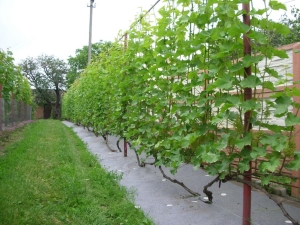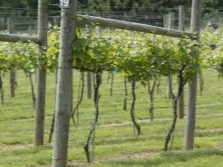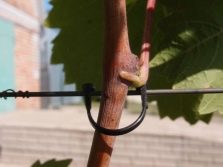How to tie grapes to the trellis?

Tying of grapes is an obligatory agrotechnical device and is widely used by both owners of large grape plantations and amateur gardeners. Competent and timely tying allows you to form a grape vine of the correct form and has a positive effect on the future harvest.
What is the garter for?
The necessity of grapevine garter is due to the requirement for the placement of bunches of grapes for more convenient collection and more optimal location relative to the sun. Otherwise, the vine will choose random supports and begin to take on the wrong chaotic forms. This will make it difficult to care for the plant, complicate the collection of fruits and increase the likelihood of uneven ripening of the grapes.
In addition, the clusters will begin to form randomly and, due to poor ventilation, may begin to rot. Spontaneously growing bushes of grapes are poorly resisted by strong gusts of wind and do not allow pinching and processing of pests in the proper volume.
Overgrown shoots will break, and on undersized sprouting of the lower buds will slow down significantly. In a favorable climate, a non-tied vine begins to grow rapidly and entangles everything around it, including other plants, fences and outbuildings. Thus, the tying of the vine must necessarily be done.
This procedure will simplify the care of the plant, will contribute to the even growth of all the shoots, significantly reduce the risk of fungal diseases, accelerate fruit ripening, facilitate pollination of peduncles and allow you to create a beautiful and neat vine.
Types of trellis
Grape trellis are classified according to several criteria, the fundamental of which is the type of construction. According to this criterion, there are two types of tapestries.
Single Plane Trellis
It is considered the best option for vertical props and is widely used on small vineyards. The device of a single-plane trellis is quite simple: two or three rows of solid wire are stretched between two adjacent pillars, and the bottom row should be located at a height of at least 50 cm from the ground. Subsequent rows are placed 40 cm apart.
The advantages of these structures is considered ease of use, the possibility of free access to the vine and use for the construction of any materials available on the holding. Among the shortcomings note the impossibility of forming several fruit vines at the same time, the risk of sagging under the influence of powerful bushes and the need to re-tie shoots as they grow.
Two-plane models
Most effective in application and practical. Tapestries of this type can be erected in two versions of the design, the first of which is a two-row model, where rows are located on both sides of the vine. In this case, the distance between the modules should not be less than 60 cm. The second design variant is two tapestries connected at its base, diverging in the upper part at a certain angle. Due to the inclined structure of the support, the sun illuminates the plants well and easily reaches the lower leaves.
The advantages of the two-plane model include the convenience of placing multi-branch bushes with six or more stems, which allows you to grow spreading varieties with a large number of side shoots. The design drawbacks are the high consumption of materials during its construction and problems in covering the vine for the winter, but the second situation is completely solvable, one has only to remove the bottom wire from the trellis.
No less important criterion by which grape trellis is divided, is the material of their manufacture. Usually it is enough for young plants to have metal or wooden pegs, while for three-year shoots it is necessary to form a full support.. As a material for the supports can be used wood, metal and reinforced concrete. Moreover, reinforced concrete products must be equipped with holes for threading wire, and wooden poles must be pretreated with a special compound that prevents wood rotting and the appearance of pests.
The optimum tree species for making trellis are chestnut and oak. The acacia’s performance is slightly worse, but nevertheless it also works. Steel pipes are used as metal pillars. They are usually welded ears for fixing the wire or, as in reinforced concrete - drill holes. The height of the pillars is usually from 2.5 to 3 meters, and thickness - 15 cm.
Wire for the construction of the trellis is better to take galvanized: it will prevent sagging and will relieve corrosion.
When and how to properly tie up?
The first garter of a rod is carried out in the spring and carries the name dry. The procedure is performed immediately after the end of the night frosts and before the first buds bloom. It should be tied up very carefully, tilting the branches in a horizontal position to the bottom wire. This arrangement will allow all the kidneys to be in the sun and will ensure a good harvest in the future.
The next garter is called green. It is produced several times over the summer. As a material for tying, you can use strips of soft fabric. This will not allow them to slip into a thin rope and injure their escape. The best option is women's nylon pantyhose, which are cut into transverse strips 2 cm wide, thus forming elastic and soft rings. As the bush grows, the nylon will begin to stretch and will not injure the shoot.
The first of the green garters is made when the shoots reach a height of 50 cm and only vertically. Thus, the main vine remains horizontally positioned, and young fruit shoots are in an upright position. Such a scheme of garter contributes to the uniform distribution of heat and the formation of bunches of grapes at the level of human growth. In addition, this method does not allow plants to intertwine with each other and makes them more accessible to pollination.
Vertical garter is also used for high-pitch and long-arm bushes. However, many experienced winegrowers have a negative attitude to vertical garters and advised to place shoots at an angle of 40-60 degrees.
In addition to the vertical and horizontal, often use the arc method in which the branches are tilted at a certain angle and fixed. The garter prevents damage to the shoots in case of strong winds. When planting, perennial plants are located at a slightly greater distance from each other, and the garter is carried out like a fan or half a fan. The winding of the vine with a cloth is made in the form of a loop or figure eight, and is most preferable where the leaves start to grow.
Common mistakes
Very often novice gardeners make the following mistakes:
- trying to bind the main stem vertically is fundamentally wrong: the main stem must be in a horizontal position;
- use as materials for garter or thin wire is unacceptable - this can lead to violation of the integrity of the stem and cause the death of the shoot
- bending all the stalks of the bush in one direction is not recommended, they should be divided into two parts and laid in different directions;
- weak tension of the wire between the pillars is not allowed, in the process of growing shoots such wire sags or breaks.
In order to tie grapes to the trellis, you do not need to have any special skills. It is enough to strictly follow the rules of the procedure, observe the vine and listen to the advice of experts.
Some ways of tying grapes are described in the video below.















































